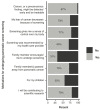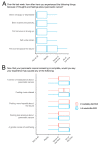Assessment of the Psychosocial Impact of Pancreatic Cancer Surveillance in High-Risk Individuals
- PMID: 38201514
- PMCID: PMC10777978
- DOI: 10.3390/cancers16010086
Assessment of the Psychosocial Impact of Pancreatic Cancer Surveillance in High-Risk Individuals
Abstract
Objectives: Pancreatic cancer (PC) surveillance of high-risk individuals (HRIs) downstages PC and improves survival. However, it remains less clear whether PC surveillance has a positive psychosocial impact on HRIs. Herein, we aimed to define the attitudes and beliefs of HRIs undergoing PC surveillance, and the immediate and sustained psychosocial impact of PC surveillance in HRIs.
Methods: 100 HRIs undergoing PC surveillance by endoscopic ultrasound (EUS) completed three surveys addressing different components of the psychosocial impact of PC surveillance. Logistic regression analyses were performed to identify predictive factors relating to these components.
Results: Most HRIs reported increased perceived benefits of PC surveillance, self-efficacy, and perceived severity of PC. HRIs reported few negative emotions prior to surveillance and frequent positive emotions after surveillance. Compared to prior to surveillance, there was a 53.5% decrease in the level of distress reported by HRIs after surveillance, which was sustained for 4-6 weeks post-surveillance. Family history of PC and lower self-reported mental health were identified as predictors for increased perceived susceptibility to PC (p < 0.01) and greater change in distress pre- to post-surveillance (p < 0.01), respectively.
Conclusions: Our findings suggest that PC surveillance can lead to sustained psychosocial benefits in HRIs.
Keywords: endoscopic ultrasound; familial pancreatic cancer; hereditary pancreatic cancer risk.
Conflict of interest statement
MK: Consultant—ACI, AGA-Varia, BSC, Dark Canyon Labs, Endiatx, Medtronic, Olympus, Virgo Systems. Equity—AGA-Varia, Dark Canyon Labs, Endiatx, EndoSound, Virgo Systems. BK: Clinical research funding: Janssen, Immunovia, Freenome, Guardant, Epigenomics, Universal Diagnostics, Recursion. The remaining authors have no conflicts of interest to disclose.
Figures




Similar articles
-
Review of the cost-effectiveness of surveillance for hereditary pancreatic cancer.Fam Cancer. 2024 Aug;23(3):351-360. doi: 10.1007/s10689-024-00392-1. Epub 2024 May 25. Fam Cancer. 2024. PMID: 38795221 Free PMC article. Review.
-
Is Biannual Surveillance for Pancreatic Cancer Sufficient in Individuals With Genetic Syndromes or Familial Pancreatic Cancer?J Natl Compr Canc Netw. 2022 Jun;20(6):663-673.e12. doi: 10.6004/jnccn.2021.7107. J Natl Compr Canc Netw. 2022. PMID: 35714671
-
Results of surveillance in individuals at high-risk of pancreatic cancer: A systematic review and meta-analysis.United European Gastroenterol J. 2018 May;6(4):489-499. doi: 10.1177/2050640617752182. Epub 2018 Jan 8. United European Gastroenterol J. 2018. PMID: 29881603 Free PMC article. Review.
-
The emotional impact of surveillance programs for pancreatic cancer on high-risk individuals: A prospective analysis.Psychooncology. 2020 Jun;29(6):1004-1011. doi: 10.1002/pon.5370. Epub 2020 Mar 10. Psychooncology. 2020. PMID: 32108397
-
Surveillance of high-risk individuals for pancreatic cancer with EUS and MRI: A meta-analysis.Pancreatology. 2020 Dec;20(8):1739-1746. doi: 10.1016/j.pan.2020.10.025. Epub 2020 Oct 9. Pancreatology. 2020. PMID: 33077384
Cited by
-
Psychological Distress and Quality of Life in Families With a Germline CDKN2A Pathogenic Variant.Mol Genet Genomic Med. 2025 Feb;13(2):e70045. doi: 10.1002/mgg3.70045. Mol Genet Genomic Med. 2025. PMID: 39936490 Free PMC article.
-
Current Approaches of Pancreatic Cancer Surveillance in High-Risk Individuals.J Gastrointest Cancer. 2025 Feb 11;56(1):61. doi: 10.1007/s12029-025-01184-1. J Gastrointest Cancer. 2025. PMID: 39932614 Free PMC article. Review.
-
Pancreatic incidentaloma: incidental findings from history towards the era of liquid biopsy.eGastroenterology. 2024 Sep 9;2(3):e100082. doi: 10.1136/egastro-2024-100082. eCollection 2024 Sep. eGastroenterology. 2024. PMID: 39944362 Free PMC article. Review.
-
Exploring the psychological burden in a pancreatic cancer surveillance programme based on high-risk individuals: a Swedish cross-sectional study.BMJ Open. 2025 Apr 30;15(4):e097814. doi: 10.1136/bmjopen-2024-097814. BMJ Open. 2025. PMID: 40306989 Free PMC article.
References
-
- NCI . SEER Cancer Stat Facts: Pancreatic Cancer. NCI; Bethesda, MD, USA: 2022.
-
- NCCN Genetic/Familial High-Risk Assessment: Breast, Ovarian, and Pancreatic (Version 3.2023) [(accessed on 11 April 2023)]. Available online: https://www.nccn.org/professionals/physician_gls/pdf/genetics_bop.pdf.
-
- Canto M.I., Hruban R.H., Fishman E.K., Kamel I.R., Schulick R., Zhang Z., Topazian M., Takahashi N., Fletcher J., Petersen G., et al. Frequent detection of pancreatic lesions in asymptomatic high-risk individuals. Gastroenterology. 2012;142:796–804. doi: 10.1053/j.gastro.2012.01.005. - DOI - PMC - PubMed
LinkOut - more resources
Full Text Sources

